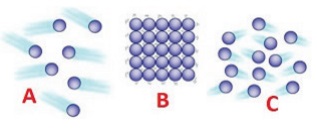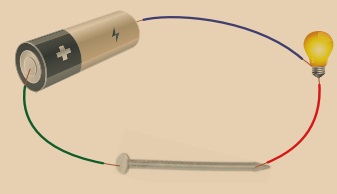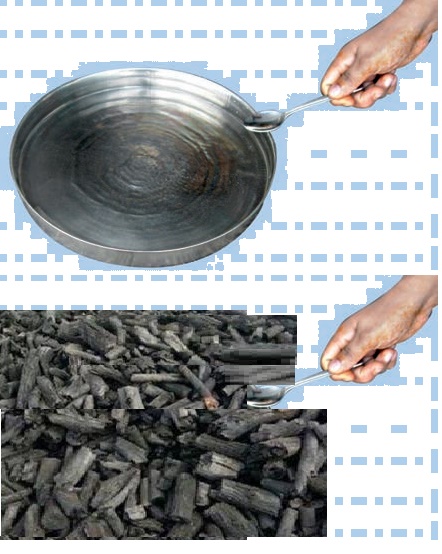Science : Chapter 9 : Matter Around Us
TEXTBOOK EXERCISE
I. Choose the best answer.
1. The liquid metal used in thermometers is
a) copper
b) mercury
c) silver
d) gold
[Answer: (b) Mercury]
2. The pictorial symbol for water given by the alchemists was

[Answer: (c) ]
3. Which one of the following element name is not derived from planet?
a) Plutonium
b) Neptunium
c) Uranium
d) Mercury
[Answer: (d) Mercury]
4. Symbol of mercury is
a) Ag
b) Hg
c) Au
d) Pb
[Answer: (b) Hg]
5. A form of non-metal which has high ductility is
a) nitrogen
b) oxygen
c) chlorine
d) carbon
[Answer: (d) carbon]
6. The property which allows the metals to be hammered into their sheets is ___________
a) ductility
b) malleability
c) conductivity
d) shining strength
[ Answer: (b) malleability]
7. The non-metal which conducts electric current is
a) carbon
b) oxygen
c) aluminium
d) sulphur
[Answer: (a) carbon]
8. Pencil lead contains
a) graphite
b) diamond
c) aluminium
d) sulphur
[Answer: (a) graphite]
9. Identify the state of matter based on the arrangement of the molecules.

a) A – Gas, B – Solid, C – Liquid
b) A – Liquid, B – Solid, C – Gas
c) A – Gas, B – Solid, C – Liquid
d) A – Liquid, B – Gas, C – Solid
[Answer: (a) A – Gas, B – Solid, C – Liquid]
II. Fill in the blanks.
1. The element which possesses the character of both metals and non metals are called metalloids.
2. The symbol of tungsten is W.
3. Melting point of most metal is higher than non-metal.
4. Water contains hydrogen and oxygen element.
5. Silicon / Germanium is used as semiconductor.
III. Match the following.
a.
Iron – For making wires
Copper – Sewing needle
Tungsten – As a fuel for ignition in rocket
Boron – Making the filament of a bulb
[Answer: 1 – B, 2 – A, 3 – D, 4 – C]
1. Iron (B) Sewing needle
2. Copper (A) For making wires
3. Tungsten (D) Making the filament of a bulb
4. Boron (C) As a fuel for ignition in rocket.
b.
Atom – Building block of matter
Element – Atoms of different kinds
Compound – Atoms of the same kind
Molecule – Smallest unit of a substance
[Answer: (a) 1 – A, 2 – C, 3 – B, 4 – D]
1. Atom (A) building block of matter
2. Element (C) atoms of the same kind
3. Compound (B) atoms of different kinds
4. Molecule (D) smallest unit of a substance
IV. Answer very briefly.
1. What is ductility?
Answer: Metals can be drawn into thin wires. This property of metals is called ductility. Example : Copper wires.
2. Write the constituent elements and their symbols for the following compounds.
a) Carbon monoxide b) Washing soda
i) Carbon monoxide – Compound : (CO), Constituent elements: Carbon and oxygen
ii) Washing soda – Compound : (Na2CO3), Constituent elements: Sodium, carbon and oxygen
3. Write the symbols for the following elements.
a) Oxygen b) Gold c) Calcium d) Cadmium e) Iron
(i) Oxygen : O
(ii) Gold : Au
(iii) calcium : Ca
(iv) cadmium : Cd
(v) Iron : Fe
4. Which non-metal is essential for our life and all living beings?
Answer: Oxygen is essential for our life and all living beings inhale it during breathing.
5. Why are bells made of metals?
Answer: On being hit, metals produce a typical sound. They are said to be sonorous. This property is being made used in making bells.
6. What does a chemical symbol represent?
Answer: A chemical symbol is a shorthand method of representing an element.
Symbol of an element signifies :
(i) Name of the element.
(ii) One atom of the element.
(iii) For example : The symbol O stands for the element of oxygen.
(iv) One atom of oxygen.
7. Give two examples for metalloids.
Answer: Boron and silicon.
8. Mention any three compounds that exist in liquid state.
Answer:
(i) Water
(ii) Hydro chloric Acid
(iii) Nitric Acid
9. Write three properties of metalloids.
Answer: Properties of metalloids :
Metalloids are all solid at room temperature.
(i) They can form alloys with other metals
(ii) Some metalloids, such as silicon and germanium, can act as electrical conductors under the specific conditions, thus they are called semiconductors.
(iii) Silicon for example appears lustrous, but is not malleable nor ductile (it is brittle – a characteristic of some non-metals). It is a much poorer conductor of heat and electricity than the metals
V. Answer briefly.
1. Can you store pickle in an aluminium utensil? Give reason.
Answer: No, we cannot store the lemon pickle in aluminium utensil because aluminium is a metal and lemon is acidic. The acids react with metals to give hydrogen which would spoil the food and makes it unfit to use.
2. Tabulate the differences between metals and non-metals.

3. Why are utensils made up of aluminium and brass?
Answer:
(i) The cooking utensils are made up of aluminium and brass because they are good conductors of heat.
(ii) Aluminium will form a layer of protective oxide that prevents further reaction. Also aluminium is also relatively cheap and that is why it is used widely in making utensils.
4. Define Alchemy.
Answer: Alchemy was form of chemistry studied in the middle age, which was concerned with trying to discover ways to change ordinary metals into gold.
5. Name the elements with the following symbols.
a) Na b) W c) Ba d) Al e) U
Answer:
(i) Na – Sodium
(ii) W-Tungsten
(iii) Ba- Barium
(iv) Al-Aluminium
(v) U- Uranium
6. Name six common non-metals and write their symbols.
Answer:
Non metals – Symbols
1. Sulphur – S
2. Carbon – C
3. Oxygen – O
4. Hydrogen – H
5. Helium – He
6. Nitrogen – N
7. Mention any four compounds and their uses.
Answer: Compounds and their uses :

8. Name the metals that are used in jewellery.
Answer: Silver and gold are used for making jewels and in decorative purposes.
9. Mention the uses of the following compounds.
a) Baking soda b) Bleaching powder c) Quick lime
i ) Baking soda : Fire extinguisher, preparation of baking powder and preparation of cakes and bread.
ii) Bleaching powder : As bleaching agent, disinfectant and sterilisation of drinking water.
iii) Quick lime : Manufacture of cement and glass.
VI. Given reason.
1. Give reasons for the following.
a. Aluminum foils are used to wrap food items.
b. Immersion rods for heating liquids are made up of metallic substances.
c. Sodium and potassium are stored in kerosene.
d. Mercury is used in thermometers.
Answer:
(i) Aluminium is malleable, soft and does not react with food items, so it is used to wrap food items.
(ii) Metals are good conductor of heat and electricity, so immersion rods are made up of metallic substances.
(iii) Sodium and potassium are very reactive, they react with air and water, so they are stored in kerosene.
(iv) Mercury is used in thermometers and barometers because of its high density and uniform expansion at different temperature.
2. Why wires cannot be drawn from materials such as stone or wood?
Answer: Wires cannot be drawn from materials such as stone or wood, is because these materials are non – metals and are brittle (non – ductile) in nature.
Student Activities
Activity 1
Take a battery, few wire pieces, a bulb, a nail and a pencil lead. First connect the nail in the circuit as shown in the figure. Is the bulb glowing? Now, connect the pencil lead in the circuit. What do you observe?


The bulb glows when the nail is connected because metal transfers energy, while the graphite lead produces heat energy.
Activity 2
Strike a metal utensil with a metal spoon. Note the kind of sound emitted. Now, strike a piece of wood charcoal with the same spoon. Do you find difference in the kind of sound produced? Most metals produce ringing sound when struck i.e. they are sonorous. Non-metals are non sonorous.















